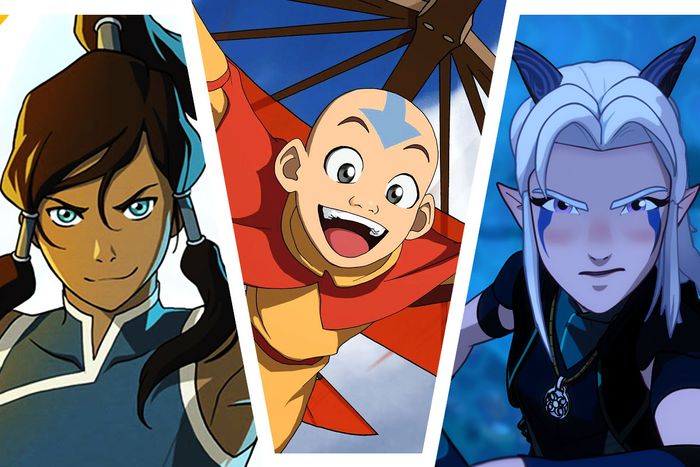
If you’re reading this list, odds are two things are true: (1) you just finished streaming Avatar: The Last Airbender on Netflix and want more, and (2) you likely remember what goes down in the show’s 39th episode, “The Guru.” It’s a classic in which Avatar Aang has a long conversation with Guru Pathik, a spiritual guide who helps him open his seven chakras, which are based, of course, on the real-world focal points for meditation.
The seven chakras serve as a thematic road map to the development of Aang and, thus, the whole series created by the episode’s credited writers, Michael Dante DiMartino and Bryan Konietzko. Positioned roughly two-thirds through Avatar’s run, “The Guru” is almost a clip show, giving both Aang and the viewers a narrative report card ahead of the second-season finale and the final season. “The challenge there was to make it not just an educational lesson,” DiMartino once said of the episode, “but to dramatize it and see how Aang struggles to deal with his past mistakes in order to grow, which is something people of all ages can relate to.”
The chakras, in other words, are useful, as well as meaningful and beautiful, in how they illustrate Aang’s journey. So in the spirit of Avatar: The Last Airbender, we’ve used them as a rubric to identify works of animation that echo Avatar’s themes, narrative choices, and character arcs. Brew yourself a cup of jasmine tea and settle into one of the series below, based on how they apply to each of the chakras and how they are connected to Avatar.
The Legend of Korra
The Earth Chakra, focusing on survival, blocked by fear
The obvious pick for a show to watch after Avatar: The Last Airbender is its sequel. The Legend of Korra, which takes place after Aang has died and a new Avatar has risen in his place, is considered by many to be an even better series, and is well known for its strides in LGBTQ+ representation in kids’ TV. But what’s most striking from the beginning of the series is how different Aang — a sprightly, breezy 12-year-old — is from Korra, a muscular, trained warrior who, at 17, has already mastered dozens of martial arts. We see plenty of Aang’s fears and resilience in Avatar, but Korra’s comparative maturity from the jump makes all of hers more explicit, especially given that she operates entirely under Aang’s shadow. Even so, the journey to proving herself is stunning to watch.
Watch The Legend of Korra on: CBS All Access
The Dragon Prince
The Water Chakra, focusing on pleasure, blocked by guilt
The more recent successor to the Avatar legacy is this show, created for Netflix by Aaron Ehasz, Avatar’s co–executive producer and head writer. The Dragon Prince has its controversies, but it tackles many of the same themes Avatar did, such as the ways families can constrain and abuse the children growing up within them. Its protagonists, like Avatar’s, are kids who undertake a perilous quest intended to unite a world divided and — fundamentally — do the right thing in returning a dragon egg to its mother. It’s a thrilling, action-packed show, but it’s also full of wonder, humor, and vibrantly designed setpieces in multicolored forests that these kids play in. They have a pet called a glow toad, which is indeed a fat, glowing toad, and the show is often a reminder of every fun and lighthearted joke that Sokka made while Team Avatar was riding Appa in the clouds.
Watch The Dragon Prince on: Netflix
Samurai Jack
The Fire Chakra, focusing on willpower, blocked by shame
“I must capture the Avatar to regain my honor!” is Prince Zuko’s constant refrain in The Last Airbender’s first season. Zuko’s willpower is what fuels him and makes him such a compelling character, and it is also the source of his great shame. It’s what makes him such a compelling, brilliant redemption story. There is more or less just one comparable story about a similarly tireless warrior racked by the same level of shame. Samurai Jack, Genndy Tartakovsky’s iconic ’00s series, wasn’t exactly a contemporary of Avatar: The Last Airbender, but it spun out of the same era of cartoon television and featured similarly ambitious action storytelling inspired by Asian influences. Its anchor was always Jack, the warrior flung into the future by an evil wizard, thus spending every episode fighting to return to his home. A few years ago, a fifth season was produced, which gave the show closure.
Watch Samurai Jack on: Adult Swim; HBO Max
Fullmetal Alchemist: Brotherhood
The Air Chakra, focusing on love, blocked by grief
When Guru Pathik reminds the Avatar that he has been able to find love despite the fact his culture underwent a horrific genocide, he tries to reassure the boy: “Let the pain flow away.” Fullmetal Alchemist: Brotherhood is what happens when that pain does not flow away. Its early episodes serve as a cautionary tale to not engage in Faustian bargains with the Devil in exchange for your loved ones’ lives, and the rest of the show delivers the consequences. Fullmetal Alchemist: Brotherhood and its lesser companion, Fullmetal Alchemist, are among the greatest anime of all time for many reasons: gorgeous animation, poignantly human characters, fascist text and subtext alike, etc. But the souls of both the FMA and Avatar franchises lie in how their heroes react to tragedy, plain and simple.
Watch Fullmetal Alchemist: Brotherhood on: Netflix; Hulu; Crunchyroll
Haikyuu!!
The Sound Chakra, focusing on truth, blocked by lies
This is one of the few recommendations on this list that doesn’t have anything to do with the supernatural or the surreal. Haikyuu!! is all about self-actualization and hormones, filtered through the trappings of a sports anime. Its leads, Shōyō Hinata and Tobio Kageyama, are a pair of teenage boys who, like Aang, gradually learn how to overcome their own worst habits in order to grow into more effective volleyball players and — most important — better teammates on their way to sporting dominance. In Avatar, Aang recalls that he initially hid his true identity from his future friends and teammates, a lesson he identifies as a necessary period of growth on his path to becoming a hero. Haikyuu!! revolves around the honesty and emotional trust it takes to build a team of athletes. If you value good sportsmanship, the training memories from Aang’s bending lessons, or the classic Karate Kid–esque “Sokka’s Master” episode, binge Haikyuu!! Its first two seasons are available on most U.S. streaming platforms.
Watch Haikyuu!! on: Netflix; Hulu; Crunchyroll
Neon Genesis Evangelion
The Light Chakra, focusing on insight, blocked by illusion
“The greatest illusion of this world is the illusion of separation,” Pathik tells Aang in Avatar. “Things you think are separate and different are actually one and the same.” So too is the central lesson of Neon Genesis Evangelion, the (in)famous anime about giant robots that dance between skyscrapers while their pilots have nervous breakdowns. Without spoiling too much, the psychology behind the characters in Hideaki Anno’s Neon Genesis Evangelion is what makes the show so charged and irresistible to discuss more than two decades after its debut. The illusion Aang identifies in Avatar is the idea that the Four Nations are somehow distinct and that their peoples are divided by nature rather than the arbitrary borders of geography and cultural difference. That they are parts of a whole is the insight he needs to open this chakra. The characters of Neon Genesis Evangelion slowly arrive at a similar, though much more explicit, conclusion once the conspiracy behind the show’s Human Instrumentality Project is revealed.
Watch Neon Genesis Evangelion on: Netflix
Steven Universe and Steven Universe Future
The Thought Chakra, focusing on pure cosmic energy, blocked by earthly attachments
The Steven Universe series is one of Avatar’s great spiritual successors thanks to both series’ shared anime influences, references to Asian cultures and mythologies, universe-spanning message of empathy and communion among different cultures, and, of course, the fact that their heroes are lads imbued with cosmic power. At the center of both Aang’s and Steven’s power sit their respective attachments to their found families and the ways their heritages interfere with those attachments. Steven Universe’s reveals are all too good to spoil, so suffice it to say that if you appreciated the fact that Aang refused to reject his earthly, romantic attachments to Katara, you will vibe with basically every season of Steven Universe’s journey, from little human-alien boy to slightly older human-alien boy. (P.S.: There will be hot dogs.)
Watch Steven Universe on: Hulu; HBO Max
If you subscribe to a service through our links, Vulture may earn an affiliate commission.


